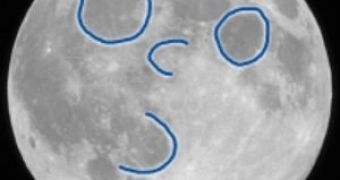The bizarre human-like face on the Moon seen from the surface of the Earth, has been created more than four billion years ago, when molten lava solidified into plains. The study revealing this fact, has been carried out by Kentaro Terada of Hiroshima University in Japan and Mahesh Anand of Britain's Open University and was published in a paper included in today's issue of Nature magazine.
Eight years ago, local people near the village of Kuke found a 13.5 kilogram rock in the Kalahari Nature Reserve, which they sold afterwards as a meteorite. On further inspection, scientists decided that this silver-gray rock was not originating from Earth, and was most likely a piece blasted from the Moon by a meteorite that had struck the general region where the human-like face is located. After being blown into space, the rock was captured by Earth's gravitational field which in turn determined its fall towards the ground in Botswana.
Chemical analysis of the rock named Kalahari 009, showed that the signature of the oxygen isotopes, iron and manganese ratios in the olivine and pyroxene volcanic rocks were specific to a category of basaltic rocks that originate in the lava flows on the Moon's surface before it had solidified, and formed dark plains that early Earth civilizations mistakenly thought to be seas.
Phosphate traces found in the rock, revealed that Kalahari 009 is about 4.35 billion years old with a margin of error of 150 million years, suggesting that the sea-type volcanism must have taken place before this date, right after the molten lava solidified into a crust.
The rocks collected during the Apollo program show evidence that this sea volcanism overlapped with a much later stage of the volcanism.
The so-called "Man in the Moon" structure visible from Earth, is composed of the Mare Imbrium and Mare Serenitatis which make the eyes, a nose consisting of Sinus Aestuum and completed by Mare Nubium and Mare Cognitum which are responsible for the mouth part of the image. To give you an idea on how big this structure is, you should know it covers about a sixth of the surface of the Moon, being placed on the most visible side from Earth.

 14 DAY TRIAL //
14 DAY TRIAL //